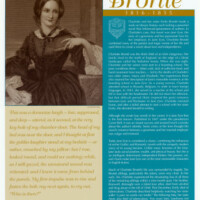Bronte or Bell?

In 1846, the three Bronte sisters published a volume of their poems. The following year, Charlotte’s “Jane Eyre and Anne’s “Agnes Grey” were published, and Emily’s “Wuthering Heights” was accepted and awaiting publication.
Writing, and most other professions, was considered an unsuitable career for women, so the reclusive Charlotte, Emily and Anne gave themselves masculine non-de-plumes. They became Currer, Acton and Ellis Bell, keeping only the first letter of their own names.
The Bronte’s vast talent, Emily’s passionate tale, their combined masculine identities and their need for seclusion, soon became the food for gossips, much to the amusement of the sisters. Charlotte wrote this letter to their publishers while she continued with the mundane chores of a dutiful daughter.
I put your most friendly letter into Emily’s hands as soon as I had myself perused it. The North American Review is worth reading; there is no mincing the matter here. What a bad set the Bells must be. What appalling books they write. To-day, as Emily appeared a little easier, I thought the Review would amuse her, so I read it aloud to her and Anne.
As I sat between them at our quiet but now somewhat melancholy fireside, I studied the two ferocious authors. Ellis (Emily Bronte), the “Man of uncommon talents, but dogged, brutal and morose”, sat leaning back in his easy chair drawing his impeded breath as best he could, and looking alas, piteously pale and wasted; but it is not his wont to laugh, but he smiled half-amused and half in scorn as he listened. Acton (Anne Bronte) was sewing, no emotion ever stirs him to loquacity, so he only smiled too, dropping at the same time a single word of calm amazement to hear his character so darkly portrayed.
I wonder what the reviewer would have thought have of his own sagacity could he have beheld the pair as I did. Vainly too, might have he have looked round for the masculine partner in the firm of “Bell & Co.”. How I laugh in my sleeve when I read the solemn assertions that “Jane Eyre” was written in partnership and that it “bears the marks of more than one mind and one sex”.
The wise critics would certainly sink a degree in their own estimation if they knew that yours or Mr Smith’s was the first masculine hand that touched the manuscript Of Jane Eyre and that until you or he read it no masculine eye had scanned a line of its contents, no masculine ear heard a phrase from its pages.
However, the view they take of the matter rather pleases me than otherwise. If they like I am not unwilling they should think a dozen ladies and gentlemen aided at the compilation of the book. Strange patchwork it must seem to them – this chapter being penned by Mr, and that by Miss or Mrs Bell; that character or scene being delineated by the husband, that other by the wife. The gentleman, of course, doing the rough work, the lady getting up the finer parts. I admire the idea vastly.
Charlotte’s beloved Emily had caught a bad cold at the funeral of their brother, Brampton, and the “brutal and morose” Ellis died of consumption in 1848, a year after the publication of “Wuthering Heights”.

Great British Writers – Charlotte Bronte
Buy this Poster at AllPosters.com




Recent Comments